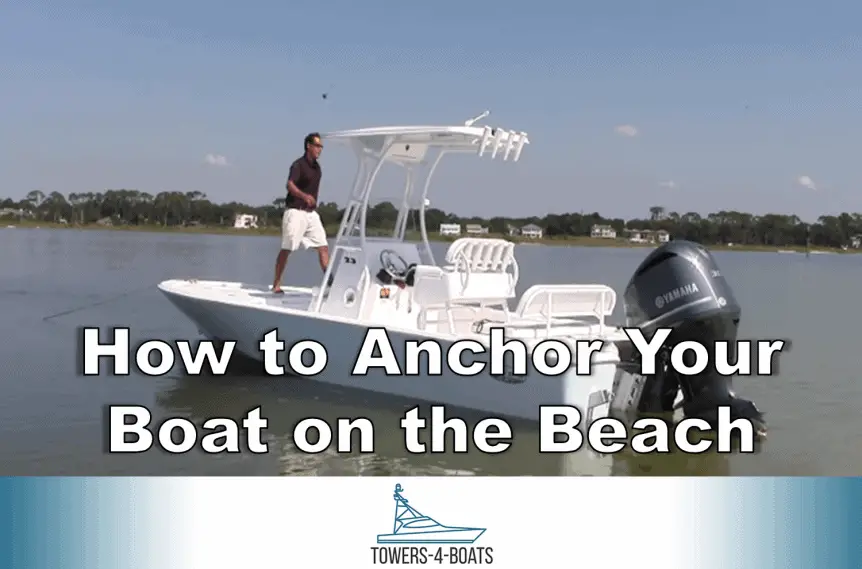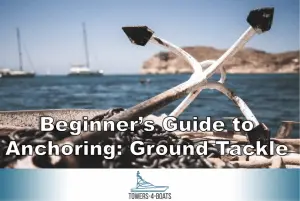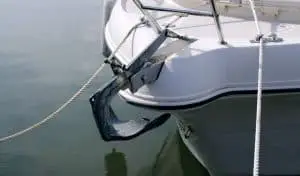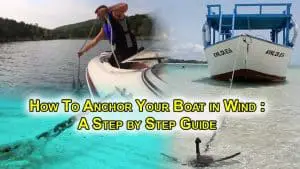Techniques for Anchoring Your Boat on a Beach
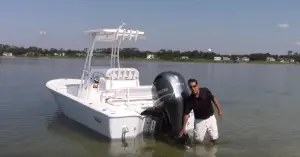 One of the most fun boating adventures is spending the day at your favorite beach or sandbar. Whether it’s a tiny spoil island along the Intercoastal Waterway or a peaceful cove on an uninhabited offshore island, you’ll want to pull up and enjoy the scenery awhile.
One of the most fun boating adventures is spending the day at your favorite beach or sandbar. Whether it’s a tiny spoil island along the Intercoastal Waterway or a peaceful cove on an uninhabited offshore island, you’ll want to pull up and enjoy the scenery awhile.
But, believe it or not, anchoring on a beach is one of the trickier things you can do in a boat. You want to make it easy to leave when you decide it’s time to go home. And you don’t want to damage or scratch your boat, a very real possibility with rocks, shells, and gritty sand all around.
Pick your spot on the beach carefully. Choose a peaceful cove with calm water. If there are breaking waves on the beach, don’t try it. The only easy way to beach on a shore with a break is to anchor outside the break and swim in. Instead, pick a quiet spot on the lee side, away from the waves, and pull right up to the beach and step off. If you’re interested, I prepared a step-by-step summary of anchoring in the wind.
Types of Anchors
A trip to your local marine hardware store will reveal that there are many types of anchor. Some designs have been around for hundreds of years, and some are modern designs with all the bells and whistles. The thing that sets one anchor apart from another is its ability to hold in different types of bottom. Large cruising boats will usually carry several anchors, and pick the best one depending on the bottom composition. Small boats seldom have that luxury, so they will tend to carry one anchor that works best in the widest range of conditions.
So what is the best anchor for small boats? The Danforth style fluke anchor is by far the most popular choice. These anchors have a lot of holding power for their small size, they fold flat for storage, and they hold well in sand and firm mud. Like pretty much all anchors, they aren’t great in grassy areas or very soft mud. In rocky areas, their sharp points usually allow them to hook onto something, but results are never guaranteed.
In rocky areas and heavy weeds, a fisherman hook style anchor will hook into the bottom well. Unfortunately, these anchors aren’t very useful in any other situation so you wouldn’t want to make it your primary.
Carrying more than one anchor is never a bad idea. If you are heading out for overnight trips and sleeping on the hook, you’ll want to have a heavy duty primary anchor that you can count on. A slightly oversized Danforth anchor, backed up by a smaller fisherman grappling hook, would be the perfect setup for most small boats.
Here is my article on River Anchors if you’re interested.
Shore Anchoring Procedure
1. Pick Your Spot
Put a little strategy into the spot you pick to spend the day. As you approach your island and beach, look for deep-water entries. If you can find deep water that goes all the way to the shore, you’ll have to worry less about the tides. In the ideal situation, you would be able to back your boat right up to the beach without the boat ever touching bottom.
When picking your spot, you also need to consider the tide. If you’re staying for any length of time, the tide is going to play a major factor. If you put the boat in shallow water or right on the waterline now and the tide goes out, your boat will likely be stuck until the tide comes back in. If you anchor too far from the beach and the tide comes in, then you’ll have to swim back to the boat.
2. Position the Anchor
Get your boat positioned about 100 to 150 feet off of the shore, and pointed away from the beach. Come to a complete stop and drop your anchor.
3. Slowly Back Up
As you back towards the beach, let out the anchor line. After about 50 feet, put the engine in neutral and let the anchor line go taut. Make sure the anchor digs in and sets, and that the boat stops. Now that your anchor is locked in place continue reversing and letting out more line. If you have an outboard, now is the time to begin tilting it to its shallow water position. Keep going until you are in knee to waist deep water.
4. Set a Stern Anchor
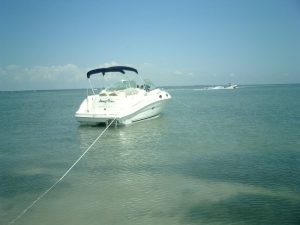 You’ll need to stop and shut off the engine before your prop hits bottom or stirs up muck. Once the boat is in knee-deep water, kill the engine and tilt it out of the water. You can continue walking the boat back towards the beach, and then secure the vessel in position by using a smaller anchor set on the beach or by tying a line ashore. The main anchor will hold the boat, but you want to keep the boat from swinging away from the beach.
You’ll need to stop and shut off the engine before your prop hits bottom or stirs up muck. Once the boat is in knee-deep water, kill the engine and tilt it out of the water. You can continue walking the boat back towards the beach, and then secure the vessel in position by using a smaller anchor set on the beach or by tying a line ashore. The main anchor will hold the boat, but you want to keep the boat from swinging away from the beach.
Getting Underway
After the day at the beach, getting underway should be easy if you did the first part right. You should be able to pick up your stern anchor, wade to the boat and step aboard. You can then go to the bow and pull the boat into deeper water as you bring in the anchor. Once you’re far enough from the beach and in deep enough water, lower your outboard and start it up. You can then bring up the rest of your anchor and get underway.
Watch this great video on how to anchor your boat on the shore from our friends at MarineMax.
Challenges to Think About
Tide Changes
The tides are going to cause you the most trouble. If the beach is very shallow for a long way from shore, it can be impossible to find a spot to get in and stay awhile without getting stuck in the mud. Look for beaches with calm water to steep drop-offs.
Waves and Boat Wakes
Waves make everything more difficult when beaching a boat. Waves harness an immense amount of power, and they can pick up your little boat and smash it down on sharp rocks in a moments notice. Picking a quiet, protected spot away from breaking waves is critical.
But waves don’t always come from open water. Boat wakes can make some serious waves too, so keep this in mind if you’re in a busy area. Big sportfishing boats, cabin cruisers, and some fast workboats can put out big waves of water. Hopefully, they aren’t cruising around near shore, but regardless, a good wake could ruin your day if you’re in shallow water.
Sharp Rocks and Coarse Sand
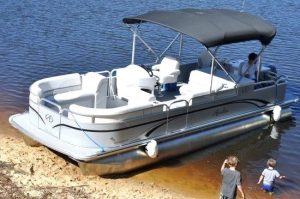 The surface of the beach plays a role in how you decide to anchor your boat. If there are sharp jagged rocks all around, you’ll need to give yourself more of a fudge factor by staying in deeper water. The anchor might not set, and if it drags or if a boat wake comes along, the damage could be severe.
The surface of the beach plays a role in how you decide to anchor your boat. If there are sharp jagged rocks all around, you’ll need to give yourself more of a fudge factor by staying in deeper water. The anchor might not set, and if it drags or if a boat wake comes along, the damage could be severe.
You’ll see many boats beached bow-first. Sand and rocks are not very forgiving to the gel coat on your fiberglass boat. If this is something you are considering doing regularly, consider installing a rubber or stainless keel strip on your boat. This is a small investment that will keep your boats gel coat in good condition.
If you keep your boat in the water, you may have bottom paint on the bottom to prevent marine growth. If you beach your boat, you’ll be scuffing off some of this expensive paint every time. But on the bright side, it is protecting the gel coat.
You can also protect your bow with protective materials like keel shield from Gator Shield (Check Pricing on Amazon
).
Prop or Impeller Damage
As you approach any shallow water, you’ll also need to be careful of avoiding damage to your prop. Stainless props are less susceptible to damage when compared to aluminum, but neither handle big rocks or solid bottoms well.
If you’re in shallow enough water to kick up sand and muck, be careful to not clog your impeller. The filter screens on your outboard will keep out the worst of the stuff, but a lot of small particulates can still make your outboard overheat. When departing the beach for the day, keep an eye on your engine temp gauges just in case.
Sunburn, Bugs, and Hydration
Ok, so none of these factors are the faults of the beach or the boat. But if you’re headed to the beach for some good times, these are all worth a mention. Your boat should always be equipped with a basic boating survival kit that goes above and beyond the basic first aid kit you buy at Wal-Mart. High SPF sunscreen, working bug spray, and lots of bottled water are must-haves on every boat.
It’s also a great idea to designate a driver for the trip home. In the sun, dehydration and alcohol can combine effects. Make sure someone in the group is in good shape to get you safely back to your home slip. And if you aren’t familiar with boating at night, try to pull up stakes before it gets too late.
Conclusion
Anchoring on the beach makes for a fun day. And with the right anchor and a little know-how, the process is easy and fun. Happy boating!

